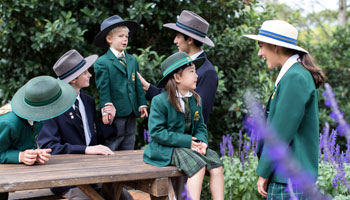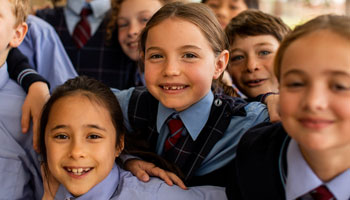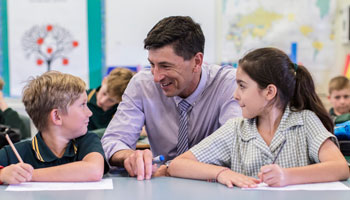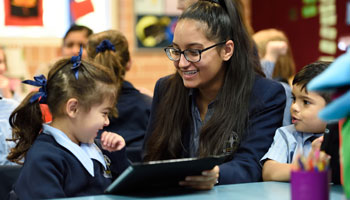Supporting students' transitions to school can greatly benefit their wellbeing and learning throughout the year.
When schools build a strong sense of belonging and connectedness into their climate, students are more likely to build positive relationships, connect to the broader school community in addition to having higher levels of motivation, engagement and overall wellbeing.
These protective factors can greatly support students' transition points, which are a challenging time as students adapt to an unfamiliar environment and seek to establish new relationships.
Transitions are successful when young people feel safe, confident and included.

Connecting new students with playground buddies or like-minded friends supports positive school transitions.
Transitions are successful when young people feel safe, confident and included. The National Mental Health and Wellbeing initiative Be You recommends schools consider a range of transitions for students including:
- from home to early learning centres
- beginning school
- moving from primary to secondary
- changing schools as well as transitioning to work or study beyond school.
It is an important time for schools to ensure new students feel welcomed, included and valued.
How might all K-12 teachers support student transitions at the start of the new school year?

Classroom meetings and circles can build connections and establish class agreements.
Connection and School Climate
Greetings and sharing provide opportunities to check-in with students and focus on relationships. Providing a welcoming physical space for students and being intentional with verbal and non-verbal body language models authentic social and emotional competencies for students. Conveying a genuine interest in building a positive relationship with students, requesting their preferred name, pronouncing and learning it quickly are important.
Connecting new students with playground buddies or like-minded friends who share similar interests can help them to feel included in social groups outside of the classroom.
Classroom meetings and circles can build connections and establish class agreements (rather than rules) and allow an opportunity to discuss school values e.g. what do we need for this class to be successful and safe and what will each student offer to create that environment?
Connecting new students with playground buddies or like-minded friends who share similar interests can help them to feel included in social groups outside of the classroom. Implementing peer-support activities helps to build connections across year levels and can be particularly reassuring for younger students. Encouraging new students to involve themselves in co-curricular activities will assist them to feel a sense of belonging to the broader school community based on their personal interests.
Remind students where support is available e.g. year and Stage coordinators, wellbeing leaders, school counsellors and chaplains/faith leaders, depending on each school context.
Sharing the curriculum and syllabus only after connections are built demonstrates that relationships are important at school. Intentionally investing in relationships at the outset of the school year supports student wellbeing, creates a positive learning environment and will also result in fewer issues throughout the year.

Sharing the curriculum and syllabus only after connections are built demonstrates that relationships are important.
Whole-school Approaches
A positive school climate can provide the perfect opportunity to support student transitions and wellbeing throughout the school year. Approaches might include:
Focusing on building partnerships with families to support wellbeing and learning in addition to responding consistently and with care to student and family concerns. This coupled with providing additional support can build trust between home and school.
Recognise that parents and carers are the best source of information about their child and encourage them to share their knowledge to enhance your understanding.
Encouraging authentic student voice and participation in broader school co-curricular opportunities e.g. creative arts, sport, debating.
Ensure parents and carers are aware of who to contact at school if support is needed.
Creating a supportive learning environment that enhances social and emotional skill development and noticing all student behaviours and ensuring transparent in-school wellbeing processes. This includes prioritising teacher and student relationships to maintain connections and taking appropriate measures to prevent or respond to student safety matters.
Encouraging authentic student voice and participation in broader school co-curricular opportunities e.g. creative arts, sport, debating.

Belonging and connectedness are key to a positive school climate.
Resources and AISNSW Support
Effective transition initiatives can prepare students for the changes and challenges they face. ReachOut and Be You have produced a range of resources designed to assist schools to plan and implement early intervention and prevention strategies to promote belonging and wellbeing in all students.
AISNSW Wellbeing resources and support for schools to access in addition to 2021 wellbeing professional learning.
Please contact AISNSW Wellbeing Consultants for advice and in-school consultancy support.

Image credits: With thanks to Australian Christian College, Marsden Park, Central Coast Grammar School, Rouse Hill Anglican College, The Scots School, Albury.
New to AISNSW and want to receive AISNSW Education News updates? Click here to register, and select ‘AISNSW Education News’ on the Areas of Interest/Subscriptions page.